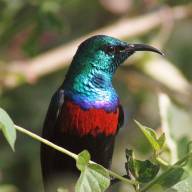(Extracted from New York Times Magazine)
By LYNN SHERR
Published: February 21, 1999
We arose at 6:30 and dressed like knights girding for battle: rip-resistant pants tucked into high socks, waterproof hiking boots laced up tight, long-sleeve shirts over thin T-shirts, garden gloves and rain gear, along with cameras and film, tucked into our many-pocketed vests. We applied bug spray to all exposed surfaces, topped by sun block, glasses and hat. At least, I thought, we looked the part.
Immediately after breakfast we went to the gathering place, where we met our fellow climbers on the day trip (a couple from Seattle, an American AIDS worker living in Kampala, a British speech therapist), enlisted our porters, joined our trackers, and piled into a truck for the short drive to the base of the mountain. There, our guide, William Betunga, a skilled and soft-spoken local resident who trained with the first group of rangers back in 1991, gave us the rules: We must stay together, we must be quiet when told, and we must never get within 15 feet of a gorilla; also, no eating, drinking, smoking or flash photography near the gorillas. And no one with a cold. Viewing time would be limited to one hour. Bwindi gorillas must not be stressed or contaminated.
We set out bravely; traipsing up a narrow path hacked out of waist-high grass. I seemed to be walking straight uphill - and up and up and up, relentlessly, as the sun beat down and the foliage grew thicker and more, well, impenetrable. At first I leaned on a six-foot walking stick, but then found the firm hand and sure step of Emanuel, my gallant teen-age porter, who was also toting our lunch and water bottles in his backpack. Emmy's older brother Eli helped Lois along.
We scrabbled upward for an hour and a half, with increasingly frequent stops for breath and for water. Then we turned into the jungle itself. Slippery, fist-thick vines and hidden sinkholes made walking treacherous; harsh branches slapped my face. We heeded every warning: ''Careful, stinging nettles - Watch your hands.'' ''Walk fast --safari ants underfoot. Stomp your feet to clear them.'' ''Beware of wasps - they can hurt.'' Half an hour more, and William announced: ''We're nearly there.'' He had brought us to the gorillas' overnight nesting place, which meant they were probably not far away. For 15 tense minutes, our trackers stalked the signs: a broken branch here, fresh dung over there. Snap! Could it be?
Suddenly, my fatigue vanished. There, through a tunnel of antediluvian ferns and moss, I saw my first mountain gorilla: a black, hairy ball quietly chomping on a branch. A surrounding symphony of rustling leaves and grunts and chest growls revealed that we were surrounded by at least a dozen animals, doing what they do naturally at high noon on a December day: eat, and rest. We humans displayed our own pattern of behavior, climbing, squatting, grinning, often ''shh-shhing'' each other and aiming our cameras at this most extraordinary sight. I watched one endearing juvenile that would not leave its mother's side; another thumped its chest in perfect King Kong style.
And then I saw the Silverback, the alpha male, the grand pooh-bah, an astonishing primeval mass of muscle bearing the patch of silver fur that marked his dominance. One swat of his immense, foot-wide hand could kill. He was a living, breathing bulldozer, thundering through the bushes with a clear sense of entitlement. Who would dare challenge a 400-pound hulk? Who would not cringe when he stood up on two legs, his six-foot height looking more like 60?
The rubbery black faces with their liquid eyes were surprisingly placid, but their strength was terrifying. One pulled down an entire tree, then picked off what must have been the most delicious shoots. Another climbed up a bush, then crashed to earth, inciting a ripple of giggles from its human kinfolk. A baby danced out on a limb, bouncing with the breeze.
The gorillas, shaggy buddhas with an air of wisdom, knew we were there, but didn't seem to mind, no doubt because they've been habituated by local trackers to tolerate human visitors. They allowed us to follow as they foraged across the mountain, and we deftly ducked the punishing tree limbs. We, too, had become a troop, traveling with them, attuned to their rhythm.
Too soon, our hour was up. Reluctantly, we withdrew and headed back down into impenetrability where, incredibly, the going was even more arduous. Now the trackers literally sliced our way home with their sharp panga knives, until we reached a clearing where we stopped to have our picnic lunch. We also took time to consider the amazingly intimate spectacle we'd just witnessed, a rare privilege. Since no mountain gorillas are in captivity anywhere (their more common western lowland cousins are the ones you've seen in most zoos), we had joined a very exclusive club.




